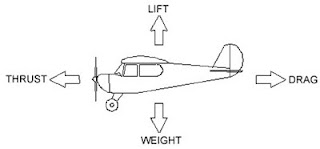Hooray! Now we have the four basic forces. When looking at these forces, we can easily see that the lift opposes the weight and the thrust opposes the drag. Typically, to simplify our analysis, we say that the aircraft is in steady, level flight. This means that the lift is equal to the weight, and the thrust is equal to the drag. In other words, the aircraft is neither climbing nor descending and it is neither speeding up nor slowing down. It would be like turning on the cruise control in your car and driving on a straight road.
Lift
But what if we want to go up? The lift must become greater than the weight. Lift can be created in two ways. The first, and easiest to understand, is called the "barn door" effect. If the plane tilts up, the bottom of the wing is exposed to the oncoming air. This forces the plane to go up. You can try this yourself! Stick your hand out your car window while driving on the freeway. Hold your hand flat with your fingers together. Now angle your hand back and you will feel the wind forcing your hand up. Ta-da! You just produced lift! The second way to produce lift is determined by the wing shape (or airfoil) and this is called aerodynamic lift. Here is a basic airfoil shape: |
 |
| Air travels from the high pressure region to the low pressure region, increasing the airspeed over the airfoil. |
Since the air never succeeds in fully restoring the pressure, the air along the top of the airfoil will always be at a lower pressure (and travelling faster) than the air along the bottom of the airfoil. The pressure difference causes the air beneath the airfoil to push harder than the air above the airfoil, resulting in lift.
Thrust
Having lift is great and all, but the only way to get it is to have air blowing over the airfoil. Since we don't want to wait for a really windy day to be able to fly, we need to produce thrust. Most commonly, this is done with either a propeller or a jet engine. A propeller acts like multiple airfoils, but on their side. As the motor spins the propeller, lift is produced from each propeller blade and the aircraft is pulled forward. A jet engine is a bit more complicated, but simplifies down to four main components:- Suck: Air is sucked in through the front of the jet engine with a fan.
- Squeeze: Air is squeezed into a really small area so that the pressure is really high.
- Bang: Fuel is injected into the compressed air and a spark ignites the air.
- Blow: The burning air-fuel mixture expands as it heats up and blows out the back of the engine.
These are the two main methods to produce thrust.
Weight
This one is pretty self explanatory. The weight of the aircraft depends on the size and materials it is made of. The first aircraft were made of wood and canvas. These aircraft did not weigh much, but moved slowly and were not very safe. With technological advancements, aircraft started being made out of metal. The type of metals vary, but aluminum is a favorite because it is lightweight and fairly inexpensive. Today, a few planes (such as the new Boeing 787) are constructed with composites, mainly carbon fiber. This makes the aircraft lighter, more fuel efficient, but much more expensive to produce.
Drag
Drag is the final aerodynamic force. It counters the thrust and is sometimes called air resistance. To understand how it works, get back in your car and get on the freeway again. When you stick your hand out the window, keep it flat with your fingers pointed straight out. Now turn your hand 90 degrees so that the palm of your hand is facing forward. Notice how much stronger the wind feels? This is because of the drag on your hand. The air molecules are hitting your hand, trying to slow you down. If you put the car in neutral (which I do NOT suggest you do on the freeway), you will eventually stop due to drag. Without a constant force applied to the aircraft (e.g. Thrust), the aircraft would slow down and fall out of the sky because of drag. There are many different types of drag, which I may discuss later, but for now that covers the basics.
These four forces are interlinked and without any one of them, we would not be able to fly. Drag seems like a pain, but the air molecules that cause drag are the same air molecules that allow us to produce lift. Without weight, we would never be able to land once we leave the ground. When designing an aircraft, we must take these four forces into consideration so that our thrust has the ability to overcome our drag and our lift can overcome the weight. If we fail to do that, then we won't have a working aircraft.
